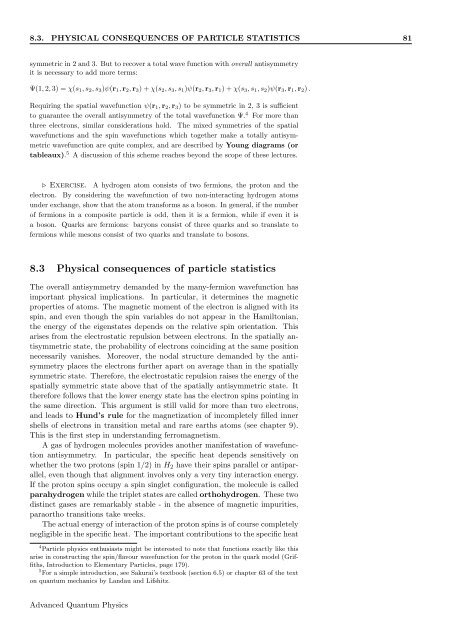Identical Particles - Theory of Condensed Matter
Identical Particles - Theory of Condensed Matter
Identical Particles - Theory of Condensed Matter
You also want an ePaper? Increase the reach of your titles
YUMPU automatically turns print PDFs into web optimized ePapers that Google loves.
8.3. PHYSICAL CONSEQUENCES OF PARTICLE STATISTICS 81<br />
symmetric in 2 and 3. But to recover a total wave function with overall antisymmetry<br />
it is necessary to add more terms:<br />
Ψ(1, 2, 3) = χ(s1,s2,s3)ψ(r1, r2, r3)+χ(s2,s3,s1)ψ(r2, r3, r1)+χ(s3,s1,s2)ψ(r3, r1, r2) .<br />
Requiring the spatial wavefunction ψ(r1, r2, r3) to be symmetric in 2, 3 is sufficient<br />
to guarantee the overall antisymmetry <strong>of</strong> the total wavefunction Ψ. 4 For more than<br />
three electrons, similar considerations hold. The mixed symmetries <strong>of</strong> the spatial<br />
wavefunctions and the spin wavefunctions which together make a totally antisymmetric<br />
wavefunction are quite complex, and are described by Young diagrams (or<br />
tableaux). 5 A discussion <strong>of</strong> this scheme reaches beyond the scope <strong>of</strong> these lectures.<br />
⊲ Exercise. A hydrogen atom consists <strong>of</strong> two fermions, the proton and the<br />
electron. By considering the wavefunction <strong>of</strong> two non-interacting hydrogen atoms<br />
under exchange, show that the atom transforms as a boson. In general, if the number<br />
<strong>of</strong> fermions in a composite particle is odd, then it is a fermion, while if even it is<br />
a boson. Quarks are fermions: baryons consist <strong>of</strong> three quarks and so translate to<br />
fermions while mesons consist <strong>of</strong> two quarks and translate to bosons.<br />
8.3 Physical consequences <strong>of</strong> particle statistics<br />
The overall antisymmetry demanded by the many-fermion wavefunction has<br />
important physical implications. In particular, it determines the magnetic<br />
properties <strong>of</strong> atoms. The magnetic moment <strong>of</strong> the electron is aligned with its<br />
spin, and even though the spin variables do not appear in the Hamiltonian,<br />
the energy <strong>of</strong> the eigenstates depends on the relative spin orientation. This<br />
arises from the electrostatic repulsion between electrons. In the spatially antisymmetric<br />
state, the probability <strong>of</strong> electrons coinciding at the same position<br />
necessarily vanishes. Moreover, the nodal structure demanded by the antisymmetry<br />
places the electrons further apart on average than in the spatially<br />
symmetric state. Therefore, the electrostatic repulsion raises the energy <strong>of</strong> the<br />
spatially symmetric state above that <strong>of</strong> the spatially antisymmetric state. It<br />
therefore follows that the lower energy state has the electron spins pointing in<br />
the same direction. This argument is still valid for more than two electrons,<br />
and leads to Hund’s rule for the magnetization <strong>of</strong> incompletely filled inner<br />
shells <strong>of</strong> electrons in transition metal and rare earths atoms (see chapter 9).<br />
This is the first step in understanding ferromagnetism.<br />
A gas <strong>of</strong> hydrogen molecules provides another manifestation <strong>of</strong> wavefunction<br />
antisymmetry. In particular, the specific heat depends sensitively on<br />
whether the two protons (spin 1/2) in H2 have their spins parallel or antiparallel,<br />
even though that alignment involves only a very tiny interaction energy.<br />
If the proton spins occupy a spin singlet configuration, the molecule is called<br />
parahydrogen while the triplet states are called orthohydrogen. These two<br />
distinct gases are remarkably stable - in the absence <strong>of</strong> magnetic impurities,<br />
paraortho transitions take weeks.<br />
The actual energy <strong>of</strong> interaction <strong>of</strong> the proton spins is <strong>of</strong> course completely<br />
negligible in the specific heat. The important contributions to the specific heat<br />
4 Particle physics enthusiasts might be interested to note that functions exactly like this<br />
arise in constructing the spin/flavour wavefunction for the proton in the quark model (Griffiths,<br />
Introduction to Elementary <strong>Particles</strong>, page 179).<br />
5 For a simple introduction, see Sakurai’s textbook (section 6.5) or chapter 63 <strong>of</strong> the text<br />
on quantum mechanics by Landau and Lifshitz.<br />
Advanced Quantum Physics

















